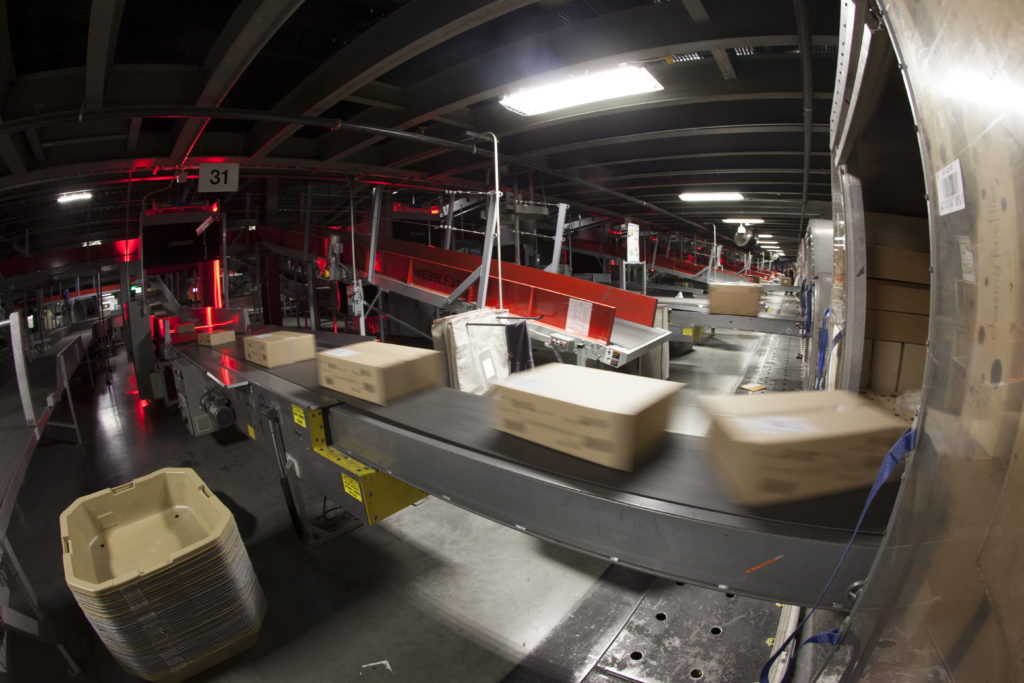No products in the cart.
FedEx’s e-commerce loss appears to be UPS’ gain

Volumes of apparel, auto parts, tablets, smartphones, knick-knacks and more are being delivered to our front doors faster and more efficiently as the two largest US small parcel and express providers, FedEx and UPS, invest in their networks, as well as in their business development and sales teams, to take advantage of this growing demand.
Indeed, in May of this year, UPS completed the expansion of its Centennial Ground hub in Louisville, Ky. The 838,000-square-foot addition triples the size of the facility to more than 1 million square feet and will accommodate the company’s increased e-commerce and traditional retail package business. In addition, the latest project also doubles the sorting capacity to 85,000 packages per hour with additional sorting automation equipment. The result of this investment will allow packages to be inserted into UPS’ Worldport air operations as late as 1:30 a.m.
Meanwhile, FedEx has announced an additional $450 million investment into its FedEx Express World Hub in Memphis in addition to its previously announced $1.1 billion modernization project in 2018. The project calls for the construction of a large new sorting facility, enhanced sort systems, construction of a bulk truckload building and a new area to better handle oversized shipments in-demand due to the e-commerce boom. The hub modernization project is expected to be completed by 2025.
E-commerce continues to grow at a break-neck speed and is taking a bigger chunk out of total retail sales. According to US Census Bureau data, e-commerce as a percentage of total retail sales represented on average 9.7% in 2018. For the first quarter of 2019, that figure jumped to 10.2%. But, as we are all aware, despite fantastic volumes, e-commerce comes with a hidden problem for many logistics providers – profitability. Quite simply, it takes more of these smaller and lighter packages to equate to profits.
Even though we cannot attribute the following data totally on the growth of e-commerce, it is telling in that FedEx Express’ Deferred and UPS’ Next Day Air service has experienced downward pressure on revenues per package. FedEx Express’ US Deferred service reported healthy year-over-year volume gains for their third quarter (period ending February 2019) and fourth quarter (period ending May 2019) periods, of 6.4% and 30.5% respectively. But, year-over-year yields slipped for each quarter, down 1.6% and 5.3%, respectively.
UPS’ Next Day Air service reported similar experiences for their first quarter (period ending March 2019) and second quarter (period ending June 2019), with year-over-year volumes increasing 18.8% and 32.9%, respectively, while average revenue per piece fell 5.4% and 6.7% year-over-year.
With Amazon controlling more and more of the US e-tail market, one wonders how much of FedEx and UPS’ volumes are attributed to the e-commerce behemoth, particularly when FedEx Express announced in June that it would not renew its annual Amazon contract. Many folks’ jaws went “thud” upon hearing this announcement. But then again, Amazon is a demanding customer, hence their success. Evidently, the two companies were not able to come to a mutually agreeable contract, but did Amazon start shifting volumes away from FedEx Express before their contract expired in June? And if so, was it to UPS?
A look at UPS’ cargo (domestic enplaned) year-over-year growth rates for their hub at the Louisville International Airport (SDF) finds the following:
- January 2019: -2.5%
- February 2019: -4.6%
- March 2019: -4.4%
- April 2019: +19.4%
- May 2019: +13.4%
- June 2019: +19.7%
It certainly looks as if something occurred beginning in April and lasting through the quarter for UPS, whereas for FedEx, at their major hub at the Memphis International Airport (MEM) for domestic enplaned, monthly year-over-year growth rates were:
- January 2019: +7.9%
- February 2019: -1.5%
- March 2019: -3.4%
- April 2019: +1.9%
- May 2019: -0.4%
- June 2019: -8.2%
FedEx Express has certainly struggled, and with the former TNT Express now folded into the division, the pressure is on for this group to demonstrate its strength in terms of profitable offerings.
What will be interesting to monitor is FedEx’s latest expansion announcement at its Centennial ground hub. As noted previously, included in this expansion is the construction of a bulk truckload building and a new area to better handle oversized shipments in-demand due to the e-commerce boom. The focus for FedEx is still e-commerce, big and small, but perhaps the larger items are where the larger profits lay?
The strategy that FedEx and UPS each take to profit from e-commerce growth will need to be creative in order to succeed. Not only that, but it will also mean being more selective in choosing customers and supply chain partners.
Cathy Morrow Roberson is founder and president of the logistics-focused market research firm, Logistics Trends & Insights, based in Atlanta. Previously, Cathy spent several years with consulting firms, as well as with UPS Supply Chain Solutions, where she supported its market, operations, competitive and mergers & acquisition research and analytics. She also is a Senior Consultant at Cargo Facts Consulting and writes a weekly column for Air Cargo World.

















